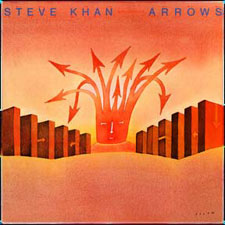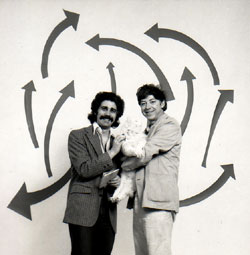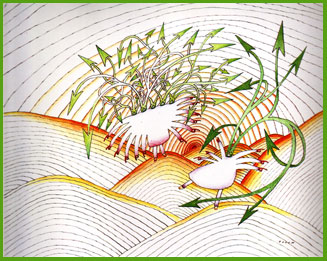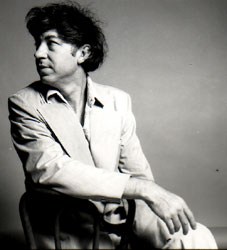Steve Khan's lead sheet:
"Candles"(Khan)
During the early '70s, here in New York, I believe that this was one of the first tunes I wrote which made some kind of compositional sense. Prior to recording "ARROWS" in 1979, "Candles" had been recorded twice before. The first time was for the Steve Marcus Count's Rock Band LP which was titled: "SOMETIME OTHER THAN NOW"(Flying Dutchman) and was released in 1976. That group then included: Don Grolnick, Will Lee and Steve Gadd. Then I was asked by Mike Mainieri to be part of the Arista All-Stars, for the "BLUE MONTREUX II"(Arista) live recording from the 1978 Montreux Jazz Festival. However, "Candles" did not appear until Volume II! The main reason it was so easy to perform this piece was the presence of Randy and Michael Brecker, who makes a rare appearance on soprano sax. On this recording, the rhythm section consisted of: Warren Bernhardt, Tony Levin, and Steve Jordan. So, having already recorded the piece twice, I decided that it was time to do something a little different with it, and add a few new arranging touches. In addition to these changes, I also knew that I wanted Rick Marotta to play drums on this tune. Those of you who are familiar with this recording will remember that Rick also appeared on "Some Arrows." Without question, Rick was the perfect drummer for a piece such as this. Don't forget, it was Mike Brecker who dubbed Rick: "The Elvin Jones of Rock!!!" Not a bad appellation if I do say so myself! The main reason it was so easy to perform this piece was the presence of Randy and Michael Brecker, who makes a rare appearance on soprano sax. On this recording, the rhythm section consisted of: Warren Bernhardt, Tony Levin, and Steve Jordan. So, having already recorded the piece twice, I decided that it was time to do something a little different with it, and add a few new arranging touches. In addition to these changes, I also knew that I wanted Rick Marotta to play drums on this tune. Those of you who are familiar with this recording will remember that Rick also appeared on "Some Arrows." Without question, Rick was the perfect drummer for a piece such as this. Don't forget, it was Mike Brecker who dubbed Rick: "The Elvin Jones of Rock!!!" Not a bad appellation if I do say so myself!
There can be little doubt that "Candles" owes a great deal to early Weather Report, perhaps especially to a tune like Joe Zawinul's "Orange Lady" from the first recording. Before that piece appeared, I don't believe that any groups had experimented with improvising for long periods of time over a static major chord with such a liberal usage of all the various color tones[9th; #4; 6th and maj7th] filtering in. I suppose one could make a strong argument for what John Coltrane's Quartet did with the extended major section of their treatment of "My Favorite Things." When we had performed this tune in the past, it was always a soprano sax feature, but, for the "ARROWS" recording, I converted it into a Jimi Hendrix-esque guitar feature for my Strat with the tremolo bar. Beyond the solo section at letter [D], my main guitar never appears. I did however, overdub some electric 12-string harmonics, for which I retuned the entire instrument, and these colors appear during letter [B]. I mentioned some additional touches to the arrangement, the layout of the this piece. They appear at [I] which was previously only a "spacey vamp" over Gbmaj9/6. Now, that sonority is almost always approached from a whole-step below, and Emaj7 or B/E. At bars 7-8 you can see a nice little sequence of chords which were also new additions. These harmonies reappear, with a bit more space, at the conclusion of the solo, [D2]. All these subtle harmonic and arranging touches were enhanced when Rob Mounsey came in with his Oberheim Polyphonic Synth to orchestrate these very sections. It marked the first time that Rob and I had worked on something creative together. My co-producer, the brilliant engineer, Elliot Scheiner helped to make this union!! What a musical matchmaker! For all that has developed since then, I am most grateful. What a blessing it has been to have worked on two wonderful duo projects with Rob. To repeat myself, he is truly everything that being a complete "musician" embodies.
I suppose in some way one might be able to classify this piece as an "anthemic Jazz-Rock Fusion" ballad, and this is where the particular "caveman-esque" drumming talents of Rick Marotta are necessary. His natural laid-back groove pocket, his knowledge of just how to build sections with majestic tom-tom set-ups and fills is unequalled. The composition was totally written at my old Fender Rhodes, and at times, I have felt that anyone could have written a tune like this because it is virtually all played on the 'black keys' and centered around Gb major. I can't say enough about what Don Grolnick and Will Lee add to any performance of this tune. I know that Will made a special point of breaking-out his Fender Fretless for this one, especially to negotiate the melodic feature for bass at letter [B]. With so much of the composed portions of the tune being written out, most of what Don and Will contribute is touch and feel to the written notes. This is, in no small way, as big a contribution as one could make! However, if you have the recording, you might want to pay special attention to the guitar solo section at [D] which is where things loosen-up considerably and their improvisational creativity comes to the fore. Once again, I tried to transcribe a bit of what Will improvised to convey the light R&B feel of the section. You can hear that Rick has switched to light 16th-notes on the hi-hat as his dynamic point of departure for the section. I can't say enough about what Don Grolnick and Will Lee add to any performance of this tune. I know that Will made a special point of breaking-out his Fender Fretless for this one, especially to negotiate the melodic feature for bass at letter [B]. With so much of the composed portions of the tune being written out, most of what Don and Will contribute is touch and feel to the written notes. This is, in no small way, as big a contribution as one could make! However, if you have the recording, you might want to pay special attention to the guitar solo section at [D] which is where things loosen-up considerably and their improvisational creativity comes to the fore. Once again, I tried to transcribe a bit of what Will improvised to convey the light R&B feel of the section. You can hear that Rick has switched to light 16th-notes on the hi-hat as his dynamic point of departure for the section.
This particular lead sheet is not really a full mini-score. However, the essence of the horn parts is contained within the Rhodes right-hand at [A] and [B]. I simply assigned to the top voice to the soprano sax and lower voice to Randy's flugelhorn. From a Rhodes perspective, the most important touch, required from the player, is the liberal usage of the sustain pedal. You want to create a 'wash' of color, as the notes should appear to run together. It is not so important, in this style, that each note receives a clear articulation. That comes from the horns. Don Grolnick was especially adept at this. This is probably a good moment to discuss how the 'spelling' of various notes and chords was treated on this particular lead sheet. Because "Candles" is in Gb major, and would normally have 6 flats in the key signature, this can present some problems: [1] most Jazz players utilize the Lydian mode so a note like Cb, the natural 4th, is never going to appear, at least not in the right hand. If the harmony moves to the IV chord, as "Candles" does at bars 9-12 of [A], the question then becomes, is one going to spell that chords as Cbmaj or will one try to make it, perhaps, more simple for the players, and spell it as Bmaj? I chose the latter solution. But, the problem, [2] caused by this, is that you are then going from flats to sharps and back again. As the tune begins, I was faced with a similar question, do I spell that first chord as Cb/Fb, or, as the more familiar looking B/E? As you can see, I again chose the latter. The main reason, even if it might mean being theoretically incorrect, is just to be courteous to your fellow musicians. You want to try to make it easier for them. This way, you are not wasting time at rehearsals, and much less so at a recording. Again, it's just something to consider!
Though, from an improvisational standpoint, soloing over a static Gb major sonority would not seem to be particularly daunting nor problematical, capturing just the right attitude, mood and flavor with the guitar is not always so simple. One obviously has a couple of simple modal options: the major scale/Ionian mode or the Lydian mode, which is, in this case Gb major/Lydian[Gb, Ab, Bb, Cb/C, Db, Eb, F]. Sometimes when younger players are introduced to the degree of the #4, here a C-natural, they go way overboard in trying to play in a way, as if to say, "Look what a far-out note I'm playing!" My feeling is very much the opposite. I think that, if you were going to employ that pitch/interval, you would not want to make such a 'big deal' out of it and that it should just occur during the normal flow of things. You will notice that Don Grolnick's accompaniment never suggests or forces me in that direction. It just happened as the line was unfolding. Normally, when improvising over a maj7 chord in any Jazz-related context, I would always suggest leaning on the minor pentatonic built upon the 3rd. In this case of Gbmaj7, that would be: Bb minor pentatonic[Bb, Db, Eb , F, Ab], which gives all the simple color tones. Generally speaking, in contexts such as this I wouldn't suggest using the minor pentatonic built on the 6th degree: Eb minor pentatonic[Eb, Gb, Ab, Bb, Db]. Usually I don't recommend this, because the presence of the [R]oot(Gb) tends to rub against the major 7th and therefore does not sound very good. However, in this case, because Don is staying away from the maj7th and concentrating more on the degrees of the 6th/13th and 2nd/9th, the inclusion of the root becomes a good thing. When you hear my usage of 4ths in conjunction with the tremolo arm, it produces a most majestic feeling. And those moments were almost always created with Eb minor pentatonic. In contrast to this approach, when Michael Brecker's soprano takes over for the fade, the note 'C' is first introduced as a lightly played upper-neighbor to Bb. But, as he develops the solo, 'C' takes on a bit more importance, enriched by Mike's expressive vibrato. For his solo, you hear a greater emphasis placed on the usage of F minor pentatonic[F, Ab, Bb, C, Eb]. Again, this is the minor pentatonic built on the maj7th degree, and always produces the #4.
I have another not-so-pleasant recollection of the whole "BLUE MONTREUX"(Arista) project, which was assembled by Mike Mainieri. Though I had been signed to Columbia Records since '77, I always felt very close to Arista because of my "TWO FOR THE ROAD" recording with Larry Coryell, and my work with the Brecker Bros. Band. When the project was conceived, I was told that I was going to receive equal 'billing' with the other artists on the cover. This, of course, would have been a good thing for me. However, because of the intense bitterness between ex-Columbia Chieftain, Clive Davis(Arista) and Bruce Lundvall(Columbia), after a polite inquiry as to the usage of my name and image, Arista was told that they would not be allowed to use either because, after all, I was a "Columbia artist." And, they were protecting their 'investment.' So, when one sees this recording, it is as if I am almost less than a 'sideman.' What makes it all so stupid, petty, and frustrating to me is that just about one year later, I was let go, dropped from the roster, by Columbia, along with countless others!!! So, how truly 'important' could I have really been to them anyway? If they were truly considering 'building' a career for me, wouldn't having my name on the cover of two volumes of "BLUE MONTREUX" have been a good thing? Things like this contribute greatly towards artists feeling suspicious of all record executives and the A&R people who can be so controlling of our careers.
I well recall a sonic catastrophe that happened during the recording of this track, but I'm not certain that I can recount the technological specifics in an accurate manner. However, to the best of my poor faulty memory, I believe that our assistant engineer on that day did something incorrect when either alligning the multitrack machine, or in enabling the Dolby noise reduction system, and this caused us to lose some level on the recording. So, on the LP version, this track was slightly lower in level than all the rest. It could have been a disaster, necessitating that we would have had to re-cut the entire tune again. We decided to just live with this minor sonic imperfection, and to save the performance, which was really great from everyone.
Though some time has now passed since my dear friend, Jean-Michel Folon passed away in October 2005, he is always in my best thoughts when it comes to life and the expression of culture. The image I have chosen to share with you all on this page was one of the inspirations for the title, "ARROWS" and, in a stroke of luck, became the cover of "LET'S CALL THIS." As it was a 'theme' in Folon's early work, I was felt some kind of connection to his usage of the arrows. I understand it all far better now. He often said, "What would happen to the world if all the direction signs disappeared?" In closing, I again want to thank Elliot Scheiner and Doug Epstein for their hard work on this recording and especially in saving this track.
[Photos of Jean-Michel Folon and Steve Khan by Jim Houghton from 1979
Also pictured, Houghton's cat!]
|

